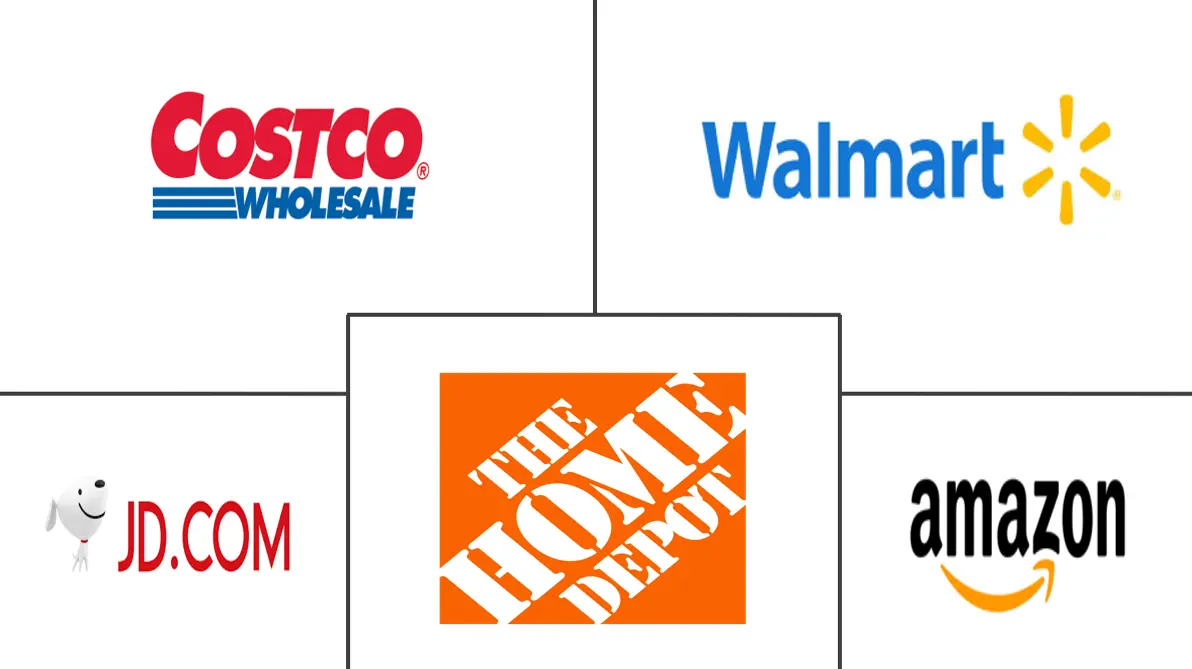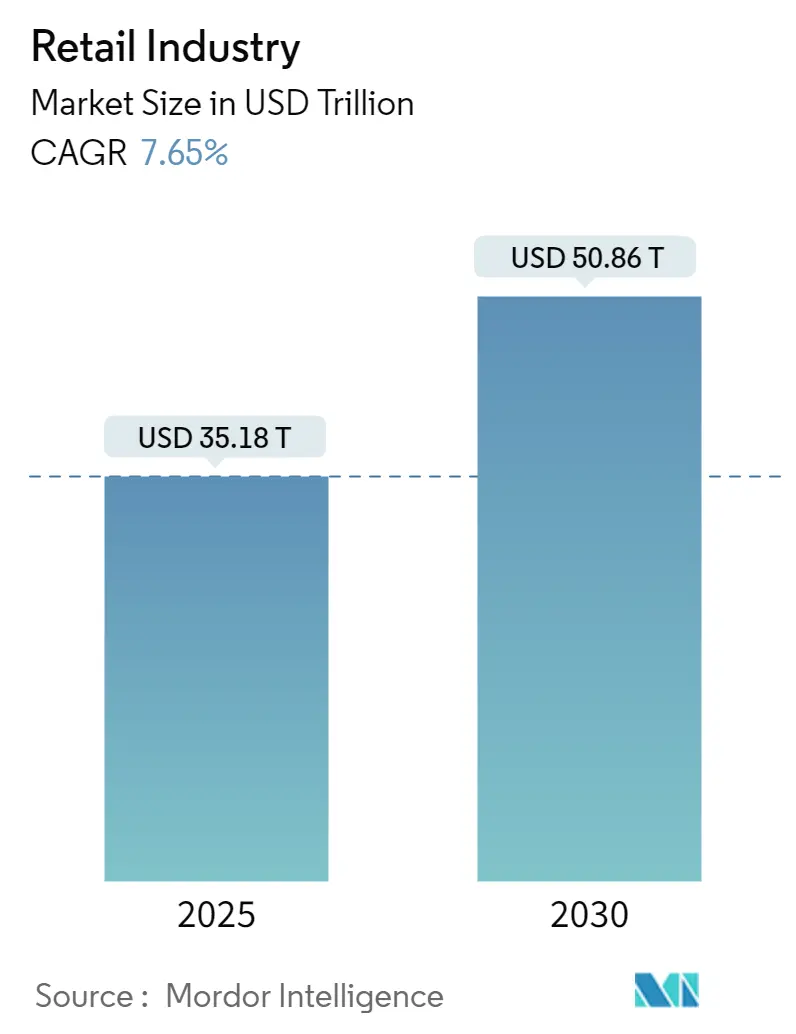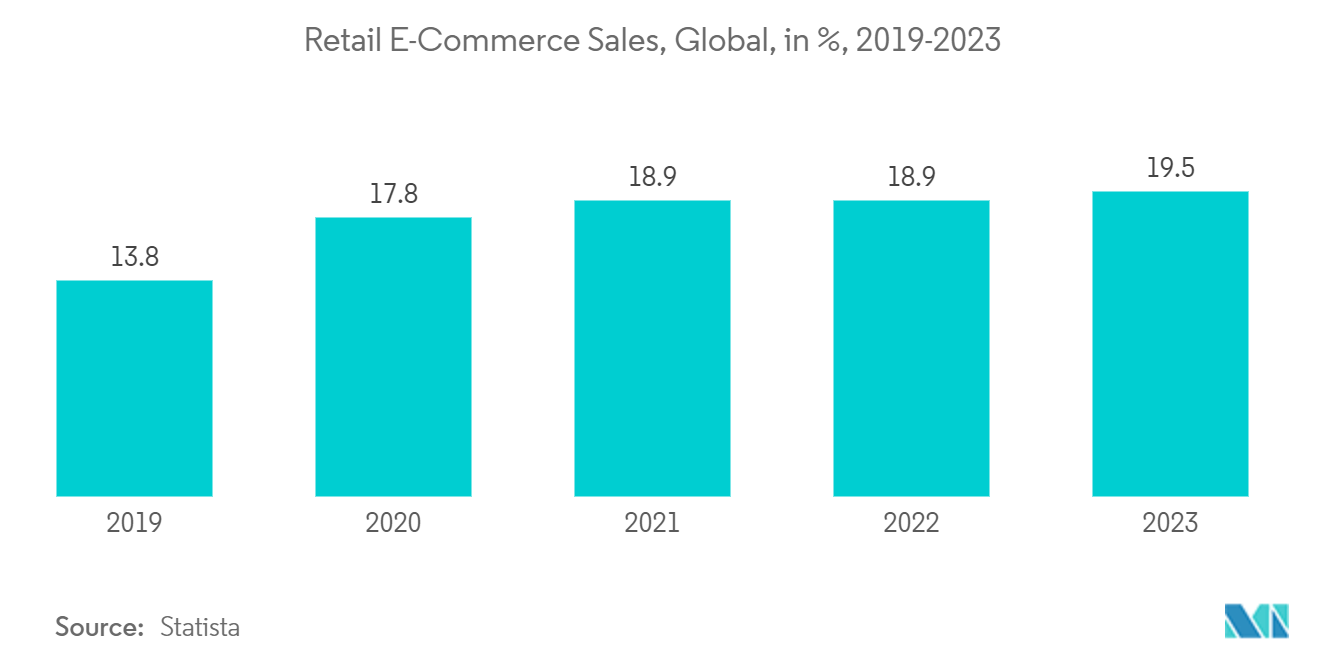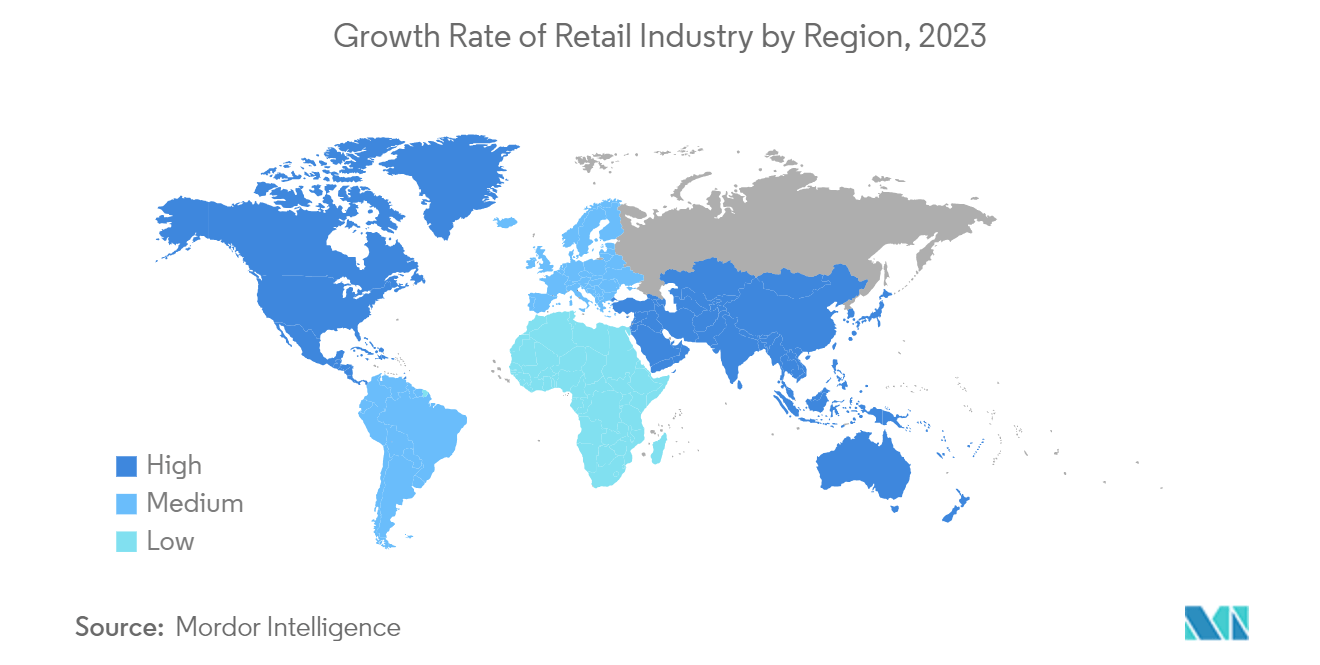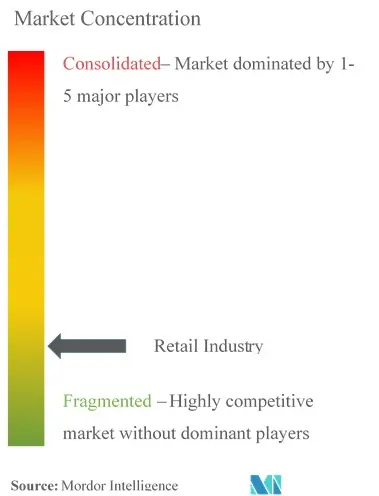Retail Market Analysis
The Retail Industry is expected to grow from USD 35.18 trillion in 2025 to USD 50.86 trillion by 2030, at a CAGR of 7.65% during the forecast period (2025-2030).
Retail is a broad and dynamic sector that includes many enterprises, from big-box retailers to conventional brick-and-mortar establishments and everything in between. The retail industry is undergoing a tremendous transition because of changing consumer tastes, technological improvements, and market trends shaping an ever-evolving landscape. E-commerce has emerged as a dominant force, fueled by the widespread adoption of digital technologies, mobile commerce, and changing shopping behaviors. Retailers increasingly leverage data analytics, artificial intelligence, and personalized marketing strategies to enhance customer experiences and drive sales.
Furthermore, the COVID-19 pandemic has expedited the transition toward multichannel retailing and online buying, forcing merchants to innovate and adjust in response to shifting customer preferences and needs. Sustainability and social responsibility have also become key considerations for retailers, with consumers increasingly seeking ethically sourced products and environmentally friendly practices. Retailers are improving their supply chain operations to improve efficiency, reduce costs, and meet increasing consumer demands for faster delivery. This includes implementing advanced inventory management systems, last-mile delivery solutions, and warehouse automation. Overall, the global retail industry remains highly competitive and dynamic, with opportunities for growth and innovation amidst evolving consumer trends and market dynamics.
Retail Market Trends
E-commerce is the Fastest-growing Segment in the Retail Industry
E-commerce has emerged as a transformative force within the retail industry, revolutionizing how businesses engage with consumers and conduct transactions. Its role and importance are undeniable, offering retailers many benefits and opportunities. Firstly, e-commerce provides retailers with a global reach and enables access to a vast online marketplace of potential customers. This expanded reach not only increases sales opportunities but also allows retailers to diversify their customer base and reduce dependency on local markets. Additionally, e-commerce enhances convenience for both retailers and consumers. Retailers can operate their businesses 24/7 without the constraints of traditional store hours, while consumers can shop anytime and anywhere, from the comfort of their homes or on the go.
E-commerce offers cost efficiencies by reducing overhead costs associated with maintaining physical storefronts, such as rent, utilities, and staffing expenses. Moreover, e-commerce enables retailers to leverage data analytics and customer insights to give personalized shopping experience, target marketing efforts more effectively, and optimize inventory management. By analyzing customer behavior and preferences, retailers can tailor product recommendations, promotions, and advertising to better meet the needs and desires of their target audience. Overall, e-commerce plays a crucial role in driving growth, expanding market reach, enhancing customer experiences, and improving operational efficiency within the retail industry.
Asia-Pacific is Anticipated to Witness the Fastest Growth Rate in the Retail Industry
Asia-Pacific is diverse, dynamic, and rapidly evolving. The region is home to some of the world's largest and fastest-growing retail markets, including China, Japan, India, South Korea, and Australia. The region's retail market is fueled by a growing middle class, urbanization, and increasing consumer spending. E-commerce has experienced explosive growth in Asia-Pacific, driven by the widespread adoption of smartphones, improved internet connectivity, and a young, tech-savvy population. Countries like China, India, and Southeast Asian nations have emerged as major e-commerce markets, with platforms like Alibaba (China), JD.com (China), Flipkart (India), and Shopee (Southeast Asia) leading the way.
Retailers in Asia-Pacific are increasingly adopting omnichannel strategies to provide seamless shopping experiences across online and offline channels. This integration allows retailers to meet the evolving needs of consumers who expect convenience, personalization, and flexibility in their shopping journeys. Convenience retail formats such as convenience stores, mini-marts, and online grocery delivery services are gaining popularity across the region. Asia-Pacific is at the forefront of digital payment adoption, with mobile payment platforms like Alipay (China), WeChat Pay (China), Paytm (India), and GrabPay (Southeast Asia) gaining widespread acceptance. Digital payments are driving the growth of e-commerce and enabling financial inclusion in the region.
Retail Industry Overview
The retail industry is highly competitive, with various local players operating in the market. To gain a competitive advantage in the industry, competitors are increasing their efforts to collaborate and utilize cutting-edge technology, such as AI and AR. Some of the key players in the market include Walmart Inc., Amazon Inc., Costco Wholesale Corporation, The Home Depot Inc., and JD.com.
Retail Market Leaders
-
Walmart Inc.
-
Amazon Inc.
-
Costco Wholesale Corporation
-
The Home Depot Inc.
-
JD.com
- *Disclaimer: Major Players sorted in no particular order
Retail Market News
- October 2023: Amazon announced that it provides online shopping services in South Africa to assist independent retailers in starting, expanding, and growing their enterprises.
- August 2023: Italian luxury fashion brand Gucci and Chinese e-commerce giant JD.com, popularly known as Jingdong, have partnered digitally. With the launch of a new digital flagship shop on the e-commerce retailer's platform, the partnership will reach a significant milestone.
- May 2023: Walmart announced the launch of over 28 healthcare facilities in its Walmart Supercenters, providing value-based and dental care services, among others.
Retail Industry Segmentation
The retail industry revolves around selling products and services to end users. Retailers buy goods from producers, distributors, or wholesalers and resell them directly to customers via a variety of channels. The retail industry is segmented by product type, distribution channel, and geography. By product type, the market is segmented into food, beverage, and grocery, personal and household care, apparel, footwear, and accessories, furniture and home décor, toys, hobby, and household appliances, and pharmaceuticals. By distribution channel, the market is segmented into supermarkets/hypermarkets, specialty stores, online stores, and other distribution channels (convenience stores and department stores). By geography, the market is segmented into North America, Europe, Asia-Pacific, Latin America, Middle East and Africa. The report offers market size and forecasts for the retail market in value (USD) for all the above segments.
| By Product Type | Food, Beverage, and Grocery |
| Personal and Household Care | |
| Apparel, Footwear, and Accessories | |
| Furniture and Home Decor | |
| Toys, Hobby, and Household Appliances | |
| Pharmaceuticals | |
| By Distribution Channel | Supermarkets/Hypermarkets |
| Specialty Stores | |
| Online | |
| Other Distribution Channels | |
| By Geography | North America |
| Europe | |
| Asia-Pacific | |
| South America | |
| Middle East and Africa |
Retail Industry Market Research Faqs
How big is the Retail Industry?
The Retail Industry size is expected to reach USD 35.18 trillion in 2025 and grow at a CAGR of 7.65% to reach USD 50.86 trillion by 2030.
What is the current Retail Industry size?
In 2025, the Retail Industry size is expected to reach USD 35.18 trillion.
Who are the key players in Retail Industry?
Walmart Inc., Amazon Inc., Costco Wholesale Corporation, The Home Depot Inc. and JD.com are the major companies operating in the Retail Industry.
Which is the fastest growing region in Retail Industry?
Asia Pacific is estimated to grow at the highest CAGR over the forecast period (2025-2030).
Which region has the biggest share in Retail Industry?
In 2025, the North America accounts for the largest market share in Retail Industry.
What years does this Retail Industry cover, and what was the market size in 2024?
In 2024, the Retail Industry size was estimated at USD 32.49 trillion. The report covers the Retail Industry historical market size for years: 2020, 2021, 2022, 2023 and 2024. The report also forecasts the Retail Industry size for years: 2025, 2026, 2027, 2028, 2029 and 2030.
Our Best Selling Reports
Retail Industry Industry Report
The retail industry market is experiencing significant growth, driven by increased customer spending in emerging economies and the rise of online shopping trends. The growing penetration of smartphones globally is also contributing to this surge, as more traffic is directed to e-commerce websites, facilitating market growth. The industry involves strategic decisions, such as the type of store and the market to be served, with emerging economies boasting rising GDPs and increased per capita income acting as key market drivers.
The introduction of new technologies like IoT and AR is reshaping the industry by providing differentiated shopping experiences. However, price variations between online and brick-and-mortar stores can act as stagnating factors. The retail industry market is segmented based on product, distribution channel, and geography, offering a wide variety of commodities for customers to purchase.
Mordor Intelligence™ Industry Reports provide valuable insights, including industry trends, sales data, industry statistics, and industry growth. These reports detail market segmentation, industry size, industry outlook, market size, and market research. They also cover market share, sector analysis, market trends, analysis reports, sales forecasts, market analysis, market reports, and market value. Additionally, the reports discuss the global market, growth rate, market index, industry data, market structure, industry information, industry profile, industry sales, market data, target market, market growth, industry PDF, industry research, market overview, consumer market, industry forecast, industry revenue, market outlook, annual report, market cap, market statistics, industry worth, market leaders, analysis PDF, growth forecast, growth statistics, market forecast, market update, industry value, market review, report PDF, size global, market capitalization, and market trend.
The retail industry analysis includes examining industry information, industry outlook, industry research, industry sales, industry size, industry statistics, industry trends, market data, market forecast, market growth, market leaders, market outlook, market overview, market predictions, market review, market segmentation, market value, report examples, report PDFs, and research companies. These comprehensive insights help stakeholders understand the industry's current state and future projections, ensuring well-informed strategic decisions.

